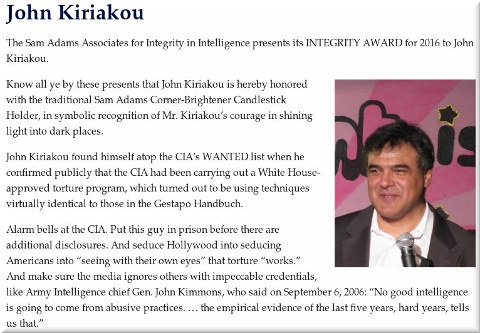
 Reference: John Kiriakou
Reference: John Kiriakou
THE management of the EPO is utterly rogue. This problem won't be resolved unless the world can see that.
Unofficial EPO Circular no. 003
Whistleblowing Guidelines
for the staff of the European Patent Office
- part 3 -
Ranking of potential targets
In general, the more power and responsibility an individual has within the Organisation, the more important is the person's responsibility for the reign of terror1 and corruption, and the lower the person's accountability. This is not always reflected by the official hierarchy. We propose the following ranking of potential targets for exposure:
PRIORITY 1:
The president of the EPO, Benoît Battistelli and the members of his inner circle2: Elodie Bergot (PD HR) and her husband Gilles Requena (administrator), René Kraft (CIO), François-Régis Hannart (PD Int. Affairs), Antoine Rety (administrator), Frédéric Angermann (external auditor). These people are old buddies of Mr Battistelli from INPI who have infiltrated the EPO, installed a reign of terror and keep filling their pockets at the expense of the European patent system. They are enemies of Europe. Their illegal actions and misdeeds are thus of the highest relevance and should be exposed without hesitation.
Furthermore, the current chairman of the Administrative Council Jesper Kongstad belongs into this priority group for being the president's closest ally and enabler.
The enforcers of the reign of terror at the EPO, i.e. the members of the Investigative Unit3, are amongst the main sources of fear and mental suffering among staff.
All persons under priority 1 enjoy presidential protection against being held accountable.
PRIORITY 2:
The vice-presidents and a certain number of principal directors at key positions keep the system running smoothly. Use your personal insight to identify those who are the most eager to support illegal measures and who receive generous monetary rewards in return.
PRIORITY 3:
Most principal directors and certain particularly influential directors or heads of department are eager to please their superiors. But they are caught in the middle of the hierarchy and they may have little choice but to obey orders. Still, many of them may have skeletons in the closet, and build their career on unscrupulous methods.
PRIORITY 4:
Heads of section, directors, team managers are at the lower end of hierarchy and their influence is usually extremely limited. While their actions and decisions affect ordinary staff in their daily work, solutions can in most cases be worked out locally within the unit.
___________ 1 http://www.dutchnews.nl/news/archives/2015/03/european-patent-office-under-fire-over-reign-of-terror/ 2 https://www.suepo.org/documents/42912/54300.pdf 3 http://techrights.org/2017/01/01/reign-of-fear-epo/
Personal disputes or doubt about a superior's managerial competence should normally not be a reason to expose the superior, e.g. by leaking an internal email or the like.
Be careful
Whisteblowers always run a risk. The EPO management is relentless and brutal. However, compared to the abundantly high number of leaked information and documents during the last four years, the EPO's rate of success in identifying whistleblowers is extremely low.
Best-practice for whistleblowers includes leaking documents which have been seen by a sufficiently large number of persons, e.g. documents which have circulated internally. When there is no urgency, better wait a few days or weeks before leaking a document. If you are one of very few persons who have seen a highly relevant document, it might even be better to secure a copy of the document and to wait instead of leaking it. In some cases, it might even be necessary to wait until the target person left the Office or lost support from top management, e.g. after the departure of Mr Battistelli.
Never upload a document from your Office PC to the web since that leaves digital traces. The same is true for exporting documents on usb sticks.
Pictures taken with private cameras contain the camera model as metadata. These can be easily removed, e.g. by the help of TAILS4. All Electronic documents contain metadata (author, software version, type and version of the operating system, time stamp, ...). This also applies to pictures taken with smart phones. All metadata need to be carefully removed with sufficiently sophisticated tools. But this is not always possible. There is, for example, no tool for securely removing metadata from pdf documents. On top of those metadata which can be easily checked by looking at a document's properties, some documents might contain so-called digital fingerprints or digital watermarks being invisible to the eye. For this reason, leaked documents should undergo a non-digital step, e.g. printing and consecutive scanning on a private device or in a copy shop (this will generate a pdf with the metadata of the scanning device used).
Be careful, take precautions, but don't be paralysed by fear. Balance the value of the document with your personal risk. If you have access to very restricted documents, like contracts with external service providers, an audio recording of a confidential meeting, Mr Kongstad's salary payslip or even the president's top secret employment agreement, the relevance of the document may be extraordinary, but your risk of being identified or interrogated will be much higher.
Good luck!
A final note to the members of the Investigative Unit
We are not afraid. Oppression fuels resistance. The light of truth burns brighter than the smouldering of lies. Those who devour others will finally devour themselves. ________ 4 https://tails.boum.org/news/